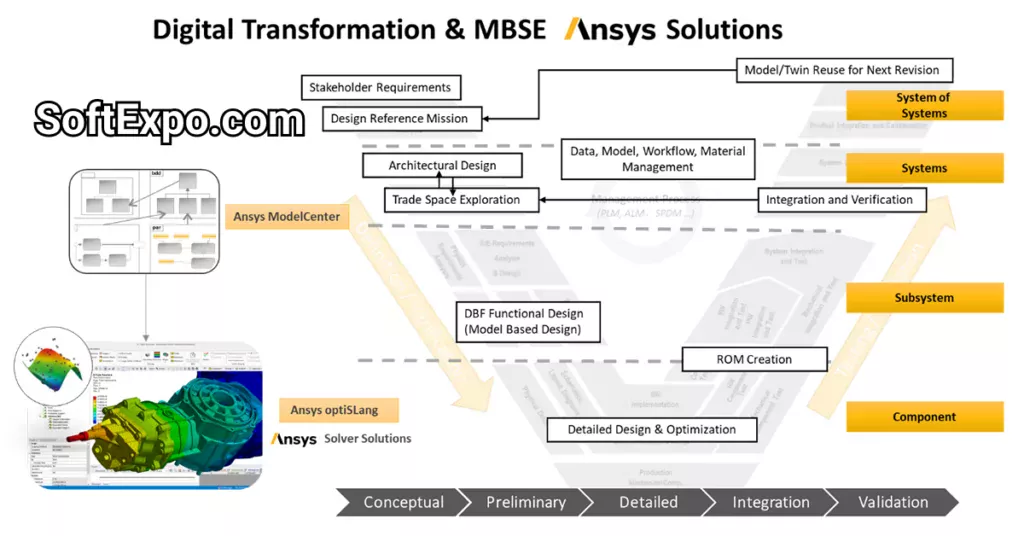All rights reserved © 2025
Ansys optiSLang is a process integration and design optimization (PIDO) platform that sits on top of your CAE tools and turns “run a few what‑ifs” into systematic robust design optimization. Instead of hand‑driving dozens of runs in Ansys Workbench or standalone solvers, you wire the workflow once, let optiSLang handle design exploration, sensitivity analysis, and uncertainty quantification, and read the results off interactive plots.
At its core, Ansys optiSLang is a framework for CAE‑based sensitivity analysis, multi‑disciplinary optimization (MDO), and robustness evaluation. It automates simulation workflows, connects to Ansys and third‑party solvers, and applies design of experiments (DOE), metamodeling, and advanced optimization algorithms to your parametric models.
Engineers use optiSLang for robust design optimization (RDO): not just finding a single “best” design, but identifying designs that stay performant under manufacturing tolerances and operating scatter. Typical tasks include design exploration, tolerance analysis, parameter calibration, and combining simulation with lab or hardware‑in‑the‑loop (HiL) data in one consistent process.

Process integration and workflow automation.
Ansys optiSLang connects to Ansys Mechanical, Fluent, HFSS, Maxwell, and many other Ansys solvers, but also to external tools such as MATLAB, Excel, Abaqus, and any solver with text‑based input. You build a process chain once—CAD, meshing, solver, post‑processing—and optiSLang handles parameter updates, job submission, and data collection across the whole chain.
Design of Experiments & sensitivity analysis.
Using DOE sampling, optiSLang maps how inputs affect outputs, then builds surrogate models (metamodels) and reports contribution of each parameter. A key metric is the Coefficient of Prognosis (COP), which measures how well a response surface predicts simulation results and underpins the Metamodel of Optimal Prognosis (MOP) workflow. This makes sensitivity analysis and design space exploration efficient even for expensive 3D simulations.
Optimization and uncertainty quantification.
Once sensitivity is understood, optiSLang supports gradient‑based methods, evolutionary algorithms, and response‑surface‑based meta‑model optimization for single‑ and multi‑objective design tasks. Its “one‑click optimizer” uses an internal AI engine to choose suitable algorithms and settings, so users do not need to be experts in numerical optimization to run serious design studies. Robustness and reliability analysis tools then evaluate how designs respond to statistical variations and noise via uncertainty quantification.
Solver‑agnostic and web‑deployable.
Because Ansys optiSLang is solver‑agnostic, you can combine structural, fluid, thermal, and electromagnetic solvers in one parametric optimization workflow. Web app publication lets you wrap complex workflows into simple forms that non‑experts can run from a browser, bringing design exploration and parametric studies to a wider engineering audience.
The 2025 R1 and R2 releases expand Ansys optiSLang with better interfaces, distributed computing, and algorithm enhancements. AI+ add‑ons and improved connectivity sharpen optimization efficiency, especially for high‑dimensional problems and mixed solver chains.
A major change in 2025 R2 is the clear path from basic to advanced functionality: optiSLang Base is now embedded in flagship Ansys solvers and Workbench, enabling in‑solver DOEs, metamodeling, and design optimization with up to 10 parameters and two objectives. This turns many routine “what‑if” and Ansys Workbench optimization tasks into first‑class features without a separate license jump, while full Ansys optiSLang still covers large‑scale, multi‑disciplinary workflows.
For students, Ansys added optiSLang to the Ansys Student offering, so academic users can learn automation, parametric analysis, tolerance analysis, and AI/ML‑based workflows using the same tools industry teams use.
In practice, most teams use Ansys optiSLang as a structured wrapper around the parametric models they already run manually:
Think of Ansys optiSLang as an automation and learning layer around your simulations: the more you invest in clean parametric models and process chains, the more value you get from DOE, MOP, and RDO. Start with relatively few variables and constraints use sensitivity analysis to prune unimportant parameters before launching large multi‑objective design exploration.
For small to medium problems, optiSLang Base inside Ansys Workbench is often enough to run design of experiments and basic optimization without leaving the solver environment. Move up to the full Ansys optiSLang platform when you need multi‑disciplinary workflows, solver‑agnostic chains, web app publication, or large‑scale robustness evaluation across many CPUs or cloud nodes.